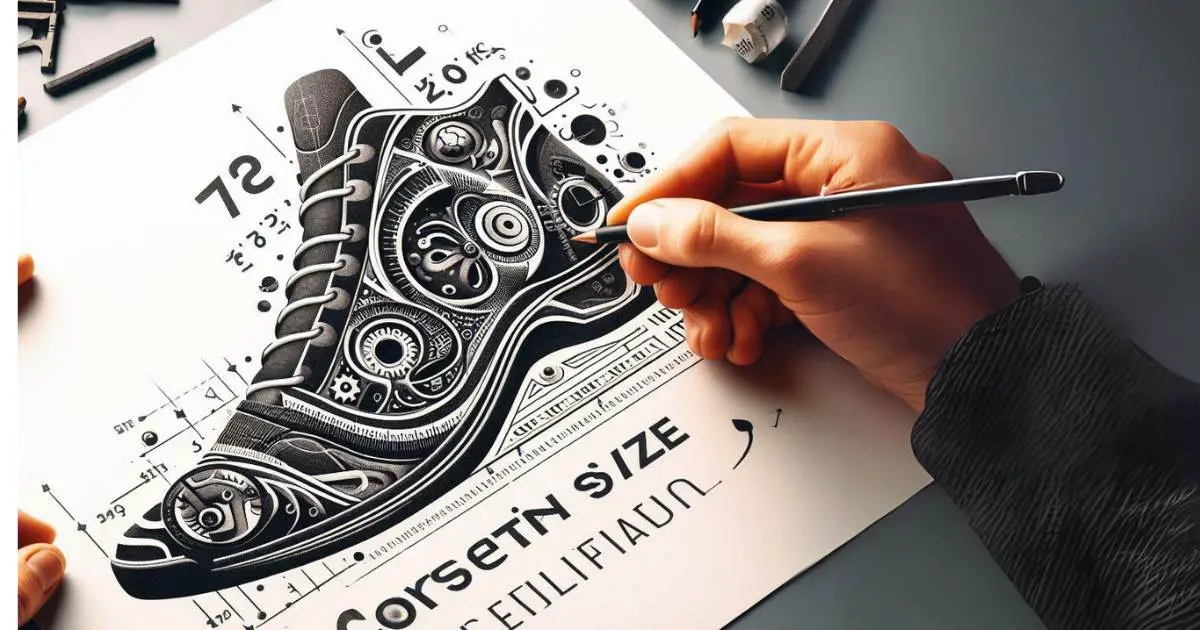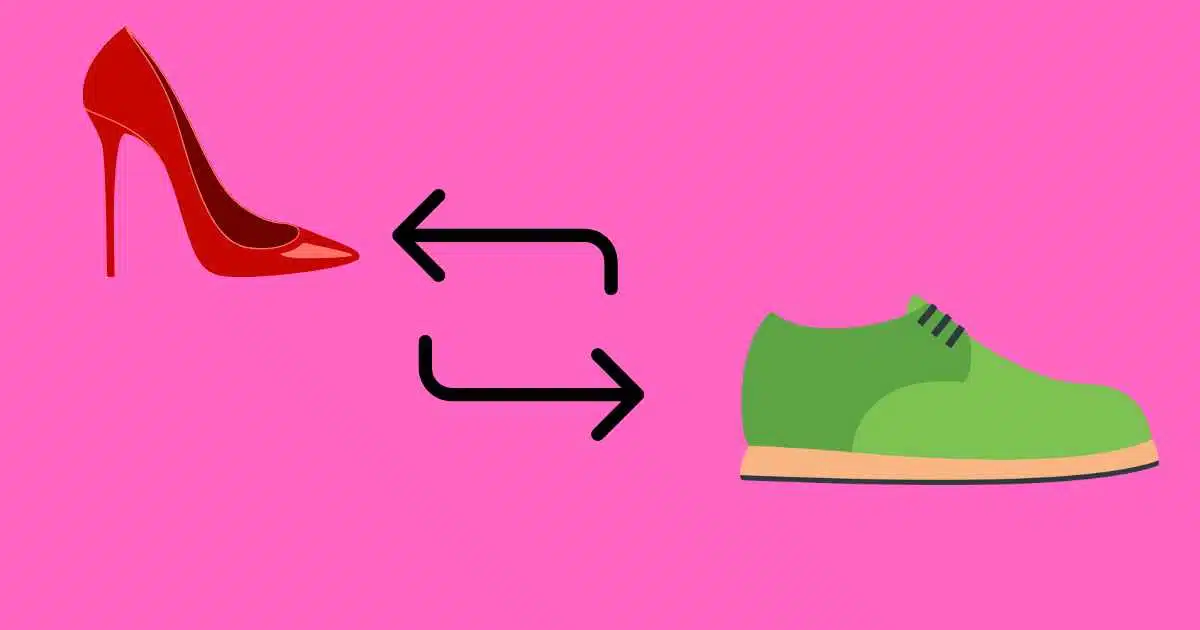To convert women’s shoe sizes to men’s, subtract 1.5 sizes from the women’s size. This calculator simplifies finding the equivalent men’s shoe size.
Have you ever wondered how to convert women’s shoe sizes to men’s? Well, worry no more! This handy women’s to men’s shoe size conversion calculator provides a simple solution for anyone looking to find the equivalent men’s shoe size for a given woman’s size. With its easy-to-use interface, this tool makes the process quick and efficient, saving you time and frustration. As someone who has struggled with finding the right shoe size conversion in the past, I understand the importance of having a reliable tool at your fingertips. By using this calculator, you can confidently shop for shoes online or in stores, knowing that you’ll get the right fit every time. So if you’re tired of guessing or struggling with conversions, give this calculator a try and simplify your shoe shopping experience!
Women’s to Men’s Shoe Size calculator
Understanding Shoe Size Conversion Online
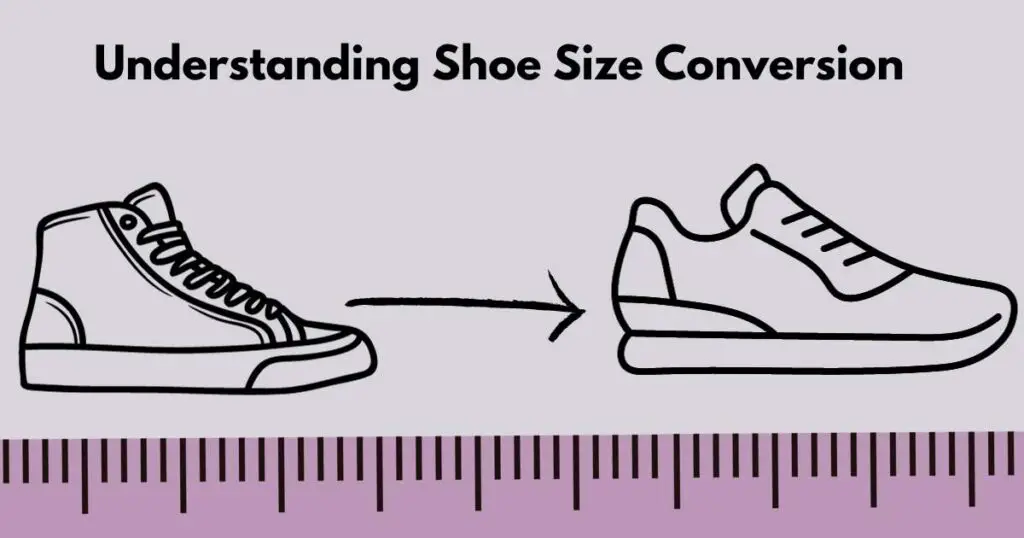
Differences between Women's and Men's Shoe Sizes
Shoe sizes are not universal. A woman's size 8 is not the same as a man's size 8. Typically, men's shoes are about 1.5 to 2 sizes larger than women's. This difference stems from variations in foot shape and width. Men's feet are often wider and longer than women's. To ensure a good fit, it's crucial to understand these differences. For instance:
- Length: Men's shoes are generally longer in the same size.
- Width: Men's shoes are built for wider feet.
- Design: The style and cut can affect the overall fit.
Why Using a Reliable Conversion Method Matters
Imagine this: you find the perfect pair of shoes online, order them, and eagerly wait for them to arrive. But when you try them on, they need to fit better. That's where a suitable conversion method comes in. It's not just about the numbers on the tag; it's about making sure the width and design match, too. A reliable conversion method, like the Women's to Men's Shoe Size Conversion Calculator, considers these details. It's like having a friend who knows your style and recommends the perfect fit every time, but in this case, it's a digital tool that makes your online shoe shopping a breeze.
Clearing Up Common Shoe Size Conversion Misconceptions
Let's tackle some myths about shoe size conversion online. First off, it's more complex than adding or subtracting a fixed number. Shoes are more complicated than that. Another misconception is that only the number matters – width and design are equally important. Suppose you're converting sizes, especially from women's to men's. In that case, it's like understanding a unique language that includes not just numbers but the subtleties of how the shoes are crafted. Clearing up these misconceptions ensures you're not just buying shoes; you're getting the right ones that fit well and look fantastic.
Women's To Men's shoe's size conversion chart
Here's a general men's and women's online shoe size conversion chart. Keep in mind that shoe sizes can vary slightly between brands and regions, so it's always a good idea to check the specific brand's sizing chart if available.
US Women's To Men's Shoe Size Conversion Table
| US Men's Size | US Women's Size |
|---|---|
| 4 | 5.5 |
| 5 | 6.5 |
| 6 | 7.5 |
| 7 | 8.5 |
| 8 | 9.5 |
| 9 | 10.5 |
| 10 | 11.5 |
| 11 | 12.5 |
| 12 | 13.5 |
| 13 | 14.5 |
| 14 | 15.5 |
UK Women's To Men's Shoe Size Conversion
| UK Men's Size | UK Women's Size |
|---|---|
| 3 | 3.5 |
| 4 | 4.5 |
| 5 | 5.5 |
| 6 | 6.5 |
| 7 | 7.5 |
| 8 | 8.5 |
| 9 | 9.5 |
| 10 | 10.5 |
| 11 | 11.5 |
| 12 | 12.5 |
EU Women's To Men's Shoe Size Conversion Table
| EU Men's Size | EU Women's Size |
|---|---|
| 35 | 36 |
| 36 | 37 |
| 37 | 38 |
| 38 | 39 |
| 39 | 40 |
| 40 | 41 |
| 41 | 42 |
| 42 | 43 |
| 43 | 44 |
| 44 | 45 |
| 45 | 46 |
These tables should provide clear conversions between men's and women's sizes in the US, UK, and EU sizing systems. Let me know if you need any additional details or changes!
what is the shoe size conversion from men's to women's
Converting men's shoe sizes to women's shoe sizes involves a simple adjustment, but keep in mind that there might be slight variations between brands. As a general rule:
- US Men's to US Women's Conversion:
- Women's size is approximately 1.5 sizes larger than men's. For example, if a man wears a size 9 in men's shoes, the equivalent women's size would be around 10.5.
- UK Men's to UK Women's Conversion:
- Women's size is generally 1.5 sizes larger than men's in the UK sizing system as well.
- EU Men's to EU Women's Conversion:
- European sizes tend to be unisex, so you usually don't need to make a conversion. However, if you want to convert, the women's size is roughly 1.5 sizes larger than men's.
Note: This is a general guide, and actual sizes may vary by brand and style. It's always a good idea to refer to the specific brand's size chart for the most accurate sizing information.
Introducing the Conversion Calculator
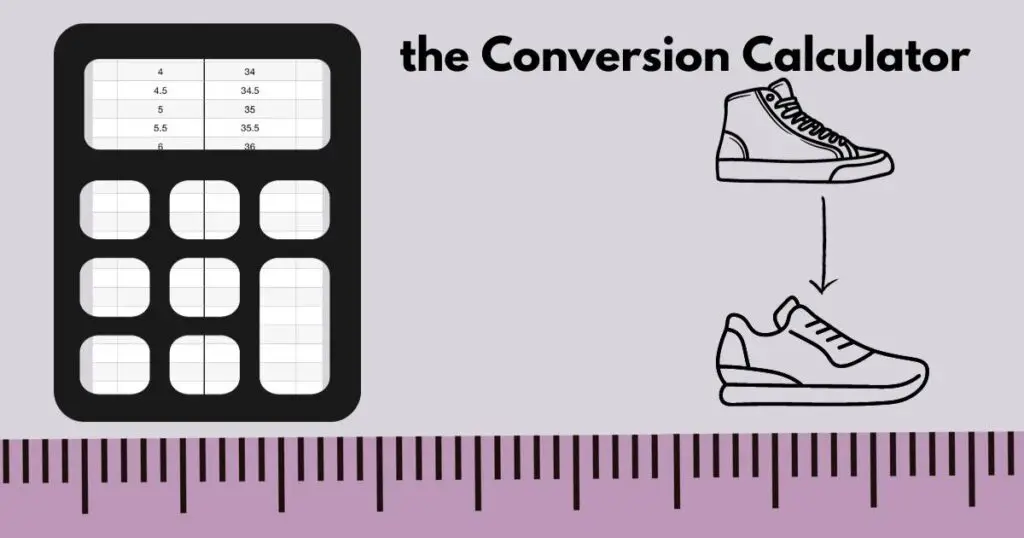
What the Calculator Does
Let's talk about this remarkable Women's to Men's Shoe Size Conversion Calculator—it's like a personal sizing assistant for your shoe-shopping adventures. Its main job is to make sure you get the right fit when crossing over from women's to men's shoes. The magic happens when you tell it your Women's Shoe Size, pick how you want the conversion (like US, UK, EU, or CM), and also mention if you're shopping for women's or men's shoes. It's a bit like having a virtual shoe sizing expert tailor your results based on both your size and gender.
How It Keeps Things Simple
What's really neat about this calculator is how easy it is to use. There's no need to be a tech wizard; it's designed for everyone. The layout is straightforward, with clear labels and input fields. But here's the special touch: it now asks if you're looking for women's or men's shoes. That's the game-changer. The calculator adapts the conversion just for you, making sure it's as accurate as possible. So, whether you're a pro at sizing or a newbie, you'll find this tool super handy and easy to navigate.
Why It's Your Shoe Sizing Sidekick
Now, here's where it gets even more remarkable. This calculator doesn't stick to just one sizing rule; it's got options. Whether you swear by the US or UK sizing system, follow the European (EU) standards, or even prefer the precision of centimeters (CM), this calculator has your back. It's like having a universal translator for shoe sizes, especially handy when you're eyeing shoes from different corners of the globe. So, wherever you are and whatever kind of shoes you're after, this calculator makes sure you're always aware of translation. It's your go-to guide for stress-free and accurate shoe sizing.
How to Use the Women's to Men's Shoe Size Conversion Calculator
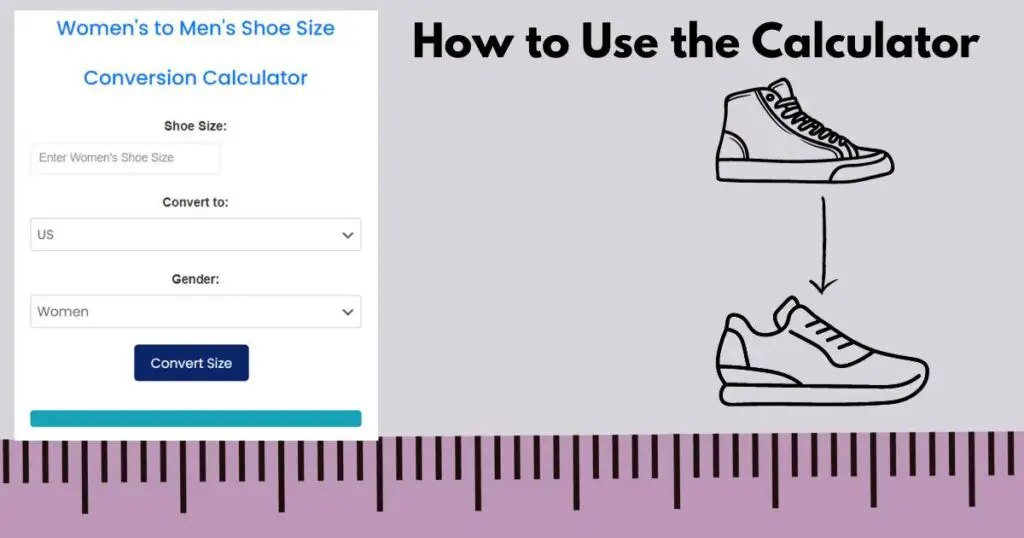
Easy Steps to Conversion Bliss:
Let's make sure you get the right fit effortlessly with our Calculator. First things first, pop in your Women's Shoe Size. Be precise; this tool loves accuracy. Now, onto the fun part – pick your Conversion Type. Whether it's US, UK, EU, or CM, choose the one that makes sense for you.
Here's the cool part: we've got gender covered, too. If you're converting for women's sizes, pick "Women." For men's sizes, go with "Men." It's like magic but for shoe sizes.
Tips for Spot-On Input:
Don't rush the shoe size entry. Take a moment to measure accurately, sticking to the same size unit as your original measurement (US, UK, EU, or CM). This first step is the secret sauce for getting spot-on conversion results.
Now, when choosing the Conversion Type, think about where you're getting those awesome shoes from. Check the brand's sizing charts and match them up. Consistency is the key here.
And about that Gender dropdown – it's there for a reason. If you're converting from women's to men's sizes, hit "Women." If it's the other way around, click "Men." It's like telling the calculator who's going to rock those shoes.
Benefits of Gender-Specific Sizing
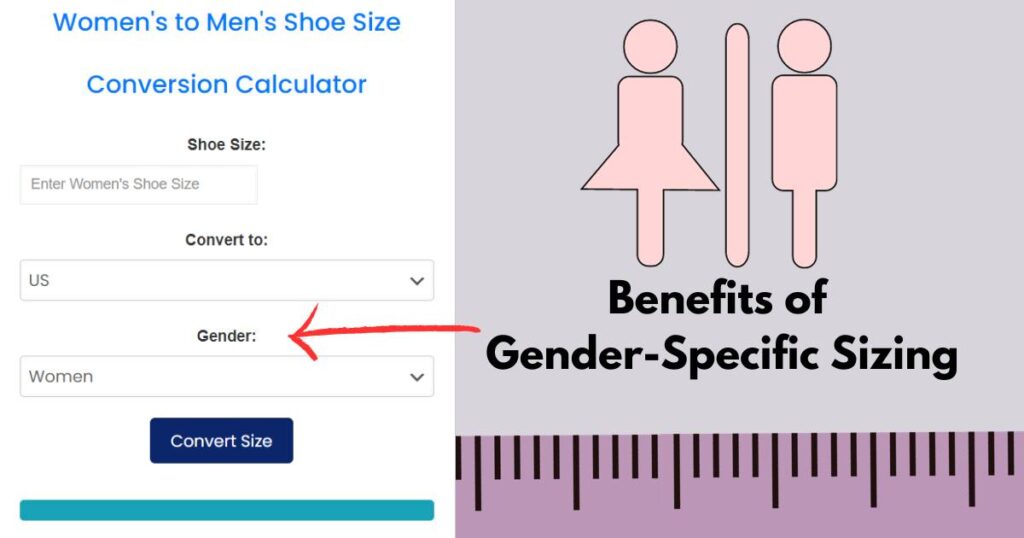
Why Gender Matters in Shoe Size Conversion:
Understanding why gender plays a role in shoe size conversion is like acknowledging that one size doesn't fit all. Men's and women's feet have their unique shapes and sizes. Women's shoes are crafted to fit a bit differently, considering the typical differences in heel and forefoot width. Ignoring these details can lead to discomfort and foot problems. The Women's to Men's Shoe Size Conversion Calculator gets this. Make sure your shoe size conversion considers these gender-specific differences. It's about more than just a number; it's about making sure your shoes actually fit the way they should.
How the Tool Understands Your Needs:
Think of the Shoe Size Conversion Calculator as your personalized shoe size assistant. It doesn't treat everyone the same. With the new gender selection feature, it caters to the specific needs of both women and men. So, if you're a woman eyeing those stylish men's shoes or a man thinking about comfortable women's sneakers, the tool's got you covered. It adjusts the size conversion to make sure you get the right fit. It's like having a friend who knows your taste in shoes and helps you pick the perfect pair.
When Gender-Specific Sizing is a Game-Changer:
Let's talk about real-life scenarios. Imagine you're a woman who loves the look of men's sneakers or a guy who wants the comfort of women's athletic shoes. Without the Women's to Men's Shoe Size Conversion Calculator, it's like navigating a fashion maze without a map. You risk ending up with shoes that don't feel right. This tool steps in to prevent those "I wish I'd known" moments. It's not just about numbers; it's about making sure your shoes match your style, regardless of traditional gender norms. It's your guide to confidently explore diverse footwear choices, ensuring every step is comfortable and uniquely yours.
Common Issues and How to Solve Them
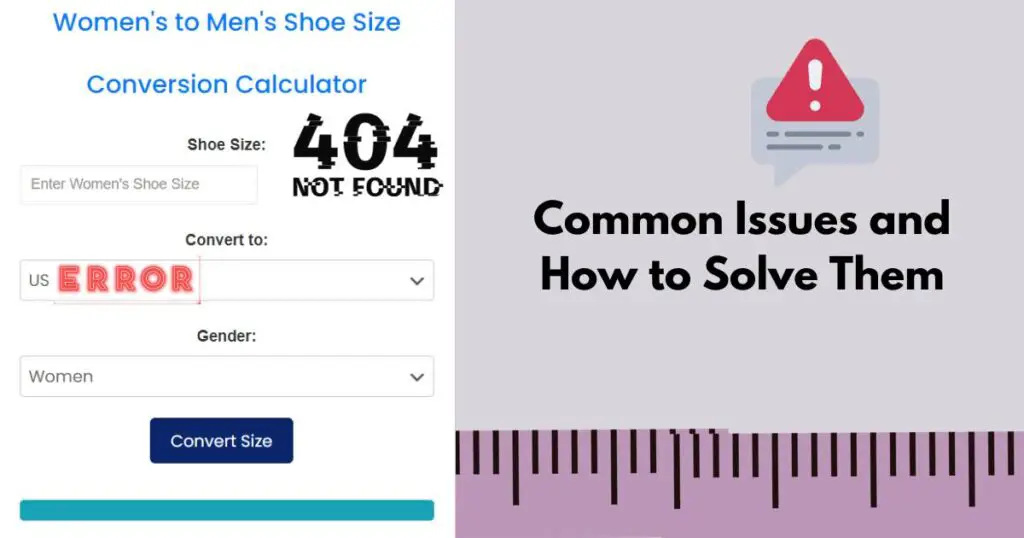
Sorting Out Possible Hiccups
Sometimes, users might run into a few bumps when using the Women's to Men's Shoe Size Conversion Calculator. One common hiccup is getting inaccurate results due to entering the wrong shoe size. It's like asking the calculator to solve a puzzle without giving it the right pieces. To avoid this, make sure you're feeding it the correct Women's Shoe Size. Also, picking the wrong conversion type or gender might cause a little confusion. Providing clear guidance on these choices and throwing in some examples could be a game-changer.
Another tricky situation is when users choose the wrong conversion type, leading to wonky results. Think of it as trying to convert miles to kilometers when you're looking for inches. To help out, explain the ins and outs of each conversion type so users know which one fits their needs.
Handy Tips for When Things Go Wonky
Suppose things start to go a bit wonky; fear not! We've got some tricks up our sleeve. If the results seem off, try going back to square one. Double-check your entries, making sure you've picked the right conversion type and gender. It's a bit like hitting the reset button on a puzzle – sometimes, you need a fresh start.
And if you're scratching your head over which conversion type to choose, don't worry – you're not alone. We've all been there. By sharing these tips, we hope to make your journey with the calculator as smooth as slipping into a comfy pair of shoes.
Let's Chat – Your Questions and Thoughts Matter!
Did you get a question or a story to share? We're all ears! Your experiences with the Women's to Men's Shoe Size Conversion Calculator are important to us. Drop a comment, tell us your triumphs or struggles, or ask anything that's on your mind. . Your insights could help us make the calculator even better. So, please don't be shy; let's make this space a cozy corner for sharing and learning together.
Choosing the Right Conversion Type
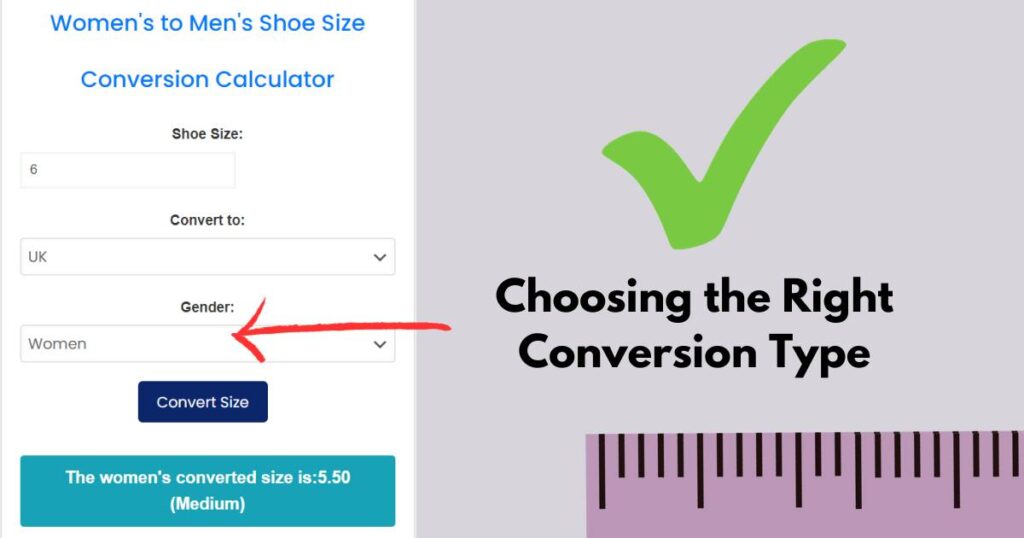
Finding shoes that fit well is essential, and using a Women's to Men's Shoe Size Calculator can make the process easier. A perfect fit means more than just getting the size right. It's about ensuring that every step is comfortable and your feet have the necessary support. Let's dive into why selecting the right fit is crucial for your feet's health and your overall comfort.
Impact Of Comfort And Support
Finding a shoe that feels like it's made just for you is a game-changer. It's not only about how it looks, but also how it feels and supports your foot. Here's why comfort and support matter:
- Prevents Blisters: Shoes that fit poorly can cause friction and lead to painful blisters.
- Reduces Foot Pain: A supportive shoe can help alleviate pain in the feet, ankles, and even the back.
- Improves Posture: Properly fitting footwear promotes good posture by providing adequate support.
- Enhances Performance: For athletes, the right shoe can improve performance and prevent injuries.
Consider the following when looking for comfort and support:
| Feature | Benefit |
|---|---|
| Cushioning | Provides shock absorption and comfort. |
| Arch Support | Helps distribute pressure and supports the foot's natural shape. |
| Breathability | Keeps feet dry and cool, reducing the risk of fungal infections. |
| Roomy Toe Box | Gives toes space to move, reducing the risk of bunions and hammertoes. |
Understanding The Importance Of Trying Shoes On
Even with a shoe size calculator, nothing beats trying shoes on for the perfect fit. Here's why:
- Feel the Fit: You can immediately sense if the shoe is tight, loose, or just right.
- Check the Width: Your foot width is as important as length. Trying on ensures width comfort.
- Test the Flexibility: You can bend the shoe to see if it matches your foot's flexing point.
- Walk Around: Walking in the shoe tells you if it slips or if there's adequate cushioning.
Remember these points when trying on shoes:
- Try shoes in the afternoon when your feet are at their largest.
- Wear the type of socks you'll wear with the shoes.
- Stand in the shoes to check for about a thumb's width of space in front of the toes.
- Walk on different surfaces if possible to test the shoe's grip and comfort.
Insights into International Sizing Standards
If you're shopping internationally or trying to figure out sizes from different parts of the world, understanding international sizing standards is like having a universal translator. The EU system, for example, is like a common language in many places. Knowing these standards helps you shop smarter and avoid surprises when your shoes arrive. The tool is like your guide, letting you smoothly move between these standards, making sure you get the right fit no matter where your shoes are coming from.
Understanding the Results
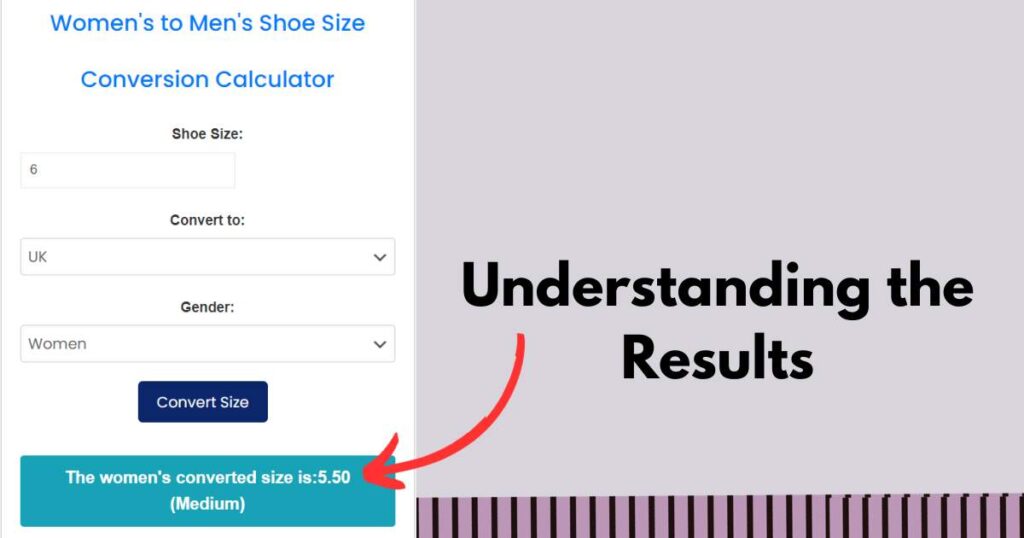
Making Sense of the Numbers:
When you use the Women's to Men's Shoe Size Conversion Calculator, the result it gives you is the equivalent men's shoe size based on the women's size you entered, the chosen conversion type (like US or UK), and whether you're converting from women's to men's shoes. It's like getting a personalized recommendation for the perfect fit. For example, if you input a women's size and pick "US" as the conversion, the tool does some behind-the-scenes math and gives you the corresponding men's size, making sure it's just right.
Reading Between the Lines - The "Medium" Clue:
The tool doesn't stop at just giving you a number; it goes the extra mile. You might notice it adding a little note, like "Medium." This extra tidbit isn't just random - it helps you pick not only the proper size but also the correct width for your shoes. Let's say you selected a woman's size, went for a US conversion, and picked "Women" as the gender. If the tool suggests a "Medium" fit, it's saying that the width of the men's shoes in that size is likely to be just perfect. It's like having a friend who knows the shoe store inside out and gives you insider tips.
Picture This with Examples:
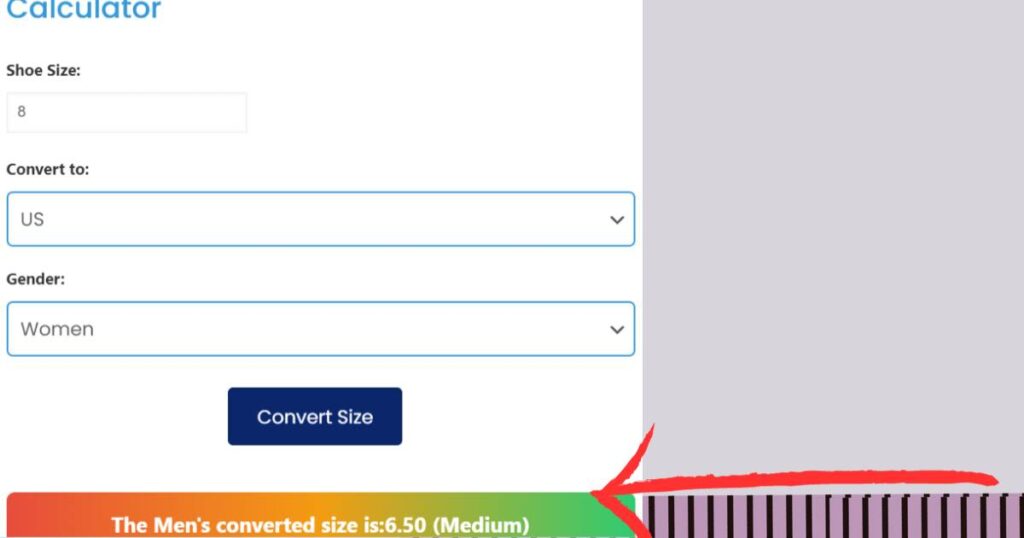
Let's make it even more straightforward with a real example. Imagine you input a woman's size 8, chose "US" for the conversion, and kept it in the "Women" category. The tool might tell you that your equivalent men's size is 6.5 (US) and suggest a "Medium" width. So, when you hit the stores or shop online, you'd be on the lookout for men's shoes in size 6.5 with that comfy medium width. These examples help you see how the tool's advice fits into your actual shoe-shopping adventure, making it less like a math problem and more like a friendly guide for finding the perfect pair.
Special Considerations
Figuring out the right shoe size can be tricky, especially when converting women's to men's sizes. But, it's not just about numbers. There are special considerations to keep in mind. They ensure a perfect fit every time. Let's delve into the details and make shoe shopping a breeze!
Sizing For Athletic And Performance Shoes
When it comes to athletic and performance shoes, the fit is critical. A perfect match boosts comfort and performance. Here are some key points to remember:
- Brand-specific sizing: Brands may have unique sizing charts. Always check the brand's official guide before buying.
- Activity type matters: Different sports need different fits. For example, runners might want a snugger fit to prevent slipping.
- Width options: Athletic shoes often come in various widths. Make sure to consider both length and width for a true fit.
Here's a quick reference table to help with the basics of athletic shoe size conversion:
Add more rows as needed
| Women's US Size | Men's US Size |
|---|---|
| 7 | 5.5 |
| 8 | 6.5 |
| 9 | 7.5 |
Remember, for a personal fit, try them on. A size calculator is a start, but your feet decide the final say.
Adapting For Unisex Or Non-binary Sizing
Unisex or non-binary sizing takes a one-size-fits-all approach, but feet are unique. Here's how to navigate this space:
- Start with a standard: Unisex models often use men's sizing as a base. Women should go down 1.5 to 2 sizes for a good fit.
- Look for size tips: Product descriptions might give clues. They can suggest if you should size up or down.
- Consider the design: Some unisex shoes are wider. Pay attention to how the shoe's shape might affect your fit.
Below is a simple chart to guide you through unisex shoe sizing:
Add more rows as needed
| Unisex Size | Women's Equivalent | Men's Equivalent |
|---|---|---|
| 6 | 7.5-8 | 6 |
| 7 | 8.5-9 | 7 |
| 8 | 9.5-10 | 8 |
Final tip: Reviews can be gold. See what others say about the fit. It can save you time and ensure your next pair feels just right.
Conclusion
We started by recognizing the common challenge of accurately converting shoe sizes between genders. We delved into the crucial considerations for achieving a precise fit. Understanding the differences in sizing standards and the impact of design variations on shoe fit became fundamental aspects of our discussion.
We elaborated on its user-friendly design, incorporating elements such as the Women's Shoe Size input, conversion type selection, and the innovative gender-specific sizing feature. This tool not only simplifies the conversion process but also addresses the nuanced needs of both women and men in their quest for comfortable and well-fitting shoes.
Frequently Asked Questions
You can convert women's to men's shoe sizes by adding approximately 1.5 to 2 sizes to the women's size. For example, if you wear a women's size 8, you might try a men's size 6.5 to 7.
Yes, width can vary between men's and women's shoes. Men's shoes are typically wider than women's. If you have a wider foot, you may need to adjust the size conversion accordingly.
While there isn't a universal conversion chart, most brands provide size conversion charts on their websites. It's advisable to refer to the specific brand's chart for accurate conversions.